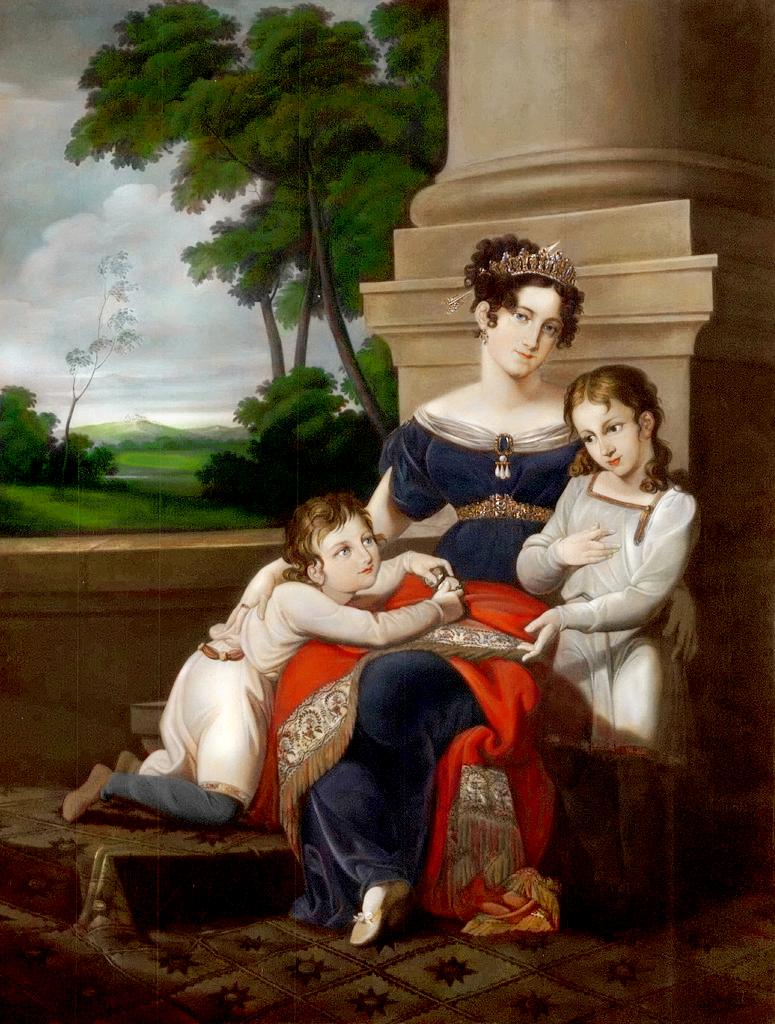
European Royalty: Saxe-Coburg-Gotha--Ernst II (1844-93)

Figure 1.--This Ernest (right) with his younger brother Albert (left) and their mother Princess Louise of Saxe-Gotha-Altenburg, shortly before their father exiled from court for infidelity. In fact their fther was much more promuscuous. At the time this was acceotable for men, but not for women, especilly royal women. This was painted about 1823-24. We are nor sure what the boys are wearing, perhaps matching tunic. This is the earliest image we have archieved of German boys wearing tunics. We do not sure yet who the artist was.
|
|
Ernest II was the eldest son of Ernst I and Princess Louise of Saxe-Gotha. He was also the nephew of Leopold I. His brother Prince Albert who caught the eye of the young Queen Victoria would play an important role in British history. The two brothers while close in age could not have been more different in temperment. Ernst and Albert grew up in their father's dysfunctional household. Both parents were promiscuous. At the time that was acceptable for men, but not for women, especially royal women. Their father eventually drove their mother from court and the boys grew up without a mother. Perhaps this is why personal rectitude and fmily values were so important to Albert. The boys were very close, but very different. Ernst took after his father who took them to brothels. Ernst took to the lifestyle. Albert was horrified. At the time Princess Victoria became Queen, both Ernst and and Albert had met her and were considered elligible partners. Their father made sure both boys learned English. Duke Ernst's interest was financial. His Duchy genberated only so much income. A family relationship with Britain, the ruchest country in Europe, was a very different matter. Ernst took note of just what it could mean when the British Givernment paid a huge stipend to his brother Leopold. Thee boys' Uncle, Belgian King Leopold I, promoted the idea. Leopold had married Princess Charlotte of Wales, the only child of the Prince Regent (the future King George IV). This brought him into the British royal family, although Princess Charlotte died in childbirth. As the brother of Princess Victoria of Saxe-Coburg-Saalfeld, the Duchess of Kent (Queen Victoria's mother), he was also the Queen's uncle. Victoria took to Albert not Ernst. Duke Ernst had thought that Ernst was the best match for Victoria. Apparently the ravages of veneral disease was already affecting Ernst's appearance. The young Queen Victoria was enjoying freedom from her mother and her associate Sir John Conroy and and was in no hurry to marry and have children. She soon fell to Albert's charms. Ernest for his part married 21-year-old Princess Alexandrine of Baden. She was the eldest daughter of Leopold, Grand Duke of Baden and Princess Sophie of Sweden. There were no children. It is thought that Ernst infected her with venerial disease rendering her sterile becaiuse he would later father iligitimate children. This mightbhace been the fate of Victoria hasd she chose Ernst. He was a strong proponent of a united Germany. He sided with Prussia in the Austro-Prussian War (1866). He was also a strong supporter of the arts, especially music. Duke Ernst died without legitimate issue (1893). He was succeeded by Albert's offspring--Alfred, Duke of Edinburgh. He was the father of Queen Marie of Romania. On Alfred's death (1900) the duchy passed to his nephew, Charles Edward, who abdicated (1918).
HBRC

Navigate the Boys' Historical Clothing Web Site royal pages:
[Return to the MainSaxe-Coburg-Gotha page]
[Return to the Main German states page]
[Austria]
[Belgium]
[France]
[Germany]
[Italy]
[Luxenburg]
[Monaco]
[Netherlands]
[Norway]
[Romania]
[Russia]
[Spain]
[Sweden]
[United Kingdom]
[Main Royalty page]
Created: 4:16 AM 8/5/2017
Last updated: 4:17 AM 8/5/2017



